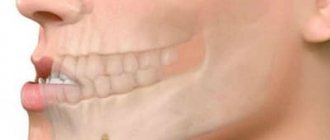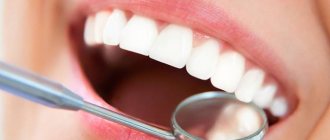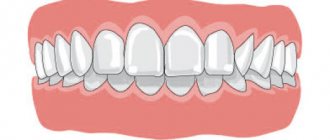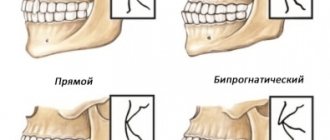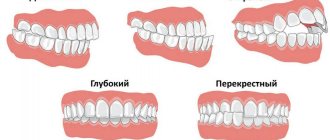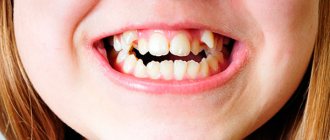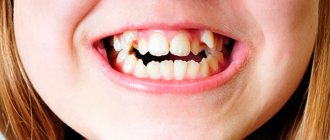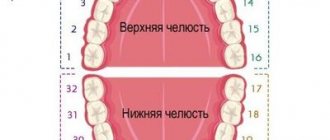One of the most common orthodontic disorders found in adults and children is deep bite. This is what experts call the type of closure of the dental arches, when the upper teeth cover the lower teeth by more than 1/3. In this case, the cutting-tubercle contact between them is disrupted.
This deviation in dentistry is also called vertical deviation of occlusion. Also used are names such as traumatic or decreasing bite, deep frontal or incisal overlap, as well as deep incisal occlusion or diocclusion. All these synonyms mean the same violation.
Causes
The reasons why such a deviation occurs can be congenital or acquired. The most common of them:
- genetic predisposition;
- congenital facial anomalies – cleft palate, cleft lip, etc.;
- a case of severe infectious disease of the mother during pregnancy;
- pathological childbirth with a period of fetal hypoxia;
- diseases in infancy and preschool age associated with dysfunction of the endocrine and respiratory systems, gastrointestinal tract, metabolic disorders;
- incorrect posture and pathologies of the development of the musculoskeletal system;
- gum tumors;
- injuries to the oral cavity or facial part of the skull;
- impaired swallowing and chewing;
- bad habits such as thumb sucking, biting the lower lip, or prolonged pacifier sucking.
Most problems, such as incorrect attachment of the frenulum of the tongue and lips, untimely replacement of primary teeth, early loss of primary molars and premolars, and dental diseases can be prevented or corrected by timely preventive care at the dentist.
In adulthood, this deviation most often results from pathological abrasion of teeth caused by looseness of bone tissue or uneven load when chewing on individual areas of the dentofacial apparatus. Incisal occlusion can result from an accident or other trauma to the skull, for example, after unsuccessful rehabilitation of rhinoplasty and other plastic surgery on the face.
Tooth wear due to deep bite
Four Main Causes of Abnormal Occlusion
- Disturbances during artificial feeding. The upper jaw of newborns is always slightly larger than the lower jaw, and if the hole in the bottle nipple is too large, then the lower jaw does not function, which deprives the child of the opportunity to correct the bite naturally. To avoid complications, parents should select nipples with a small hole for their baby, then the lower jaw will actively develop.
- Bad habits. Extra space between a child's teeth can be a result of thumb sucking or even poor posture. In such cases, consult a doctor to receive recommendations for correction and a set of devices for leveling the occlusion.
- Consequences of diseases. Breathing through the mouth instead of the nose and constantly opening the lower jaw, which often occurs during acute respiratory diseases, can cause the formation of improper occlusion and even an adenoid type of face.
- Heredity. Even if only one of the parents has an incorrect bite, space between teeth or other occlusion abnormalities, there is a risk of passing the defect on by inheritance. Moreover, in each subsequent generation the defect will be even more pronounced.
Signs
Deep bite causes a number of visual aesthetic defects and functional disorders. A person with vertical incisal occlusion has a shortened lower part of the face, the lower lip may be slightly turned outward, and a sharp groove appears above the chin. When smiling, the lower dental arch remains hidden behind the lip.
The main symptom of deep incisive occlusion is the overlap of the lower teeth by the upper teeth by more than 1/3. In this case, the upper jaw looks overhanging. Due to the disorder, the oral mucosa is chronically injured, so the patient periodically experiences episodes of stomatitis; gingivitis, periodontitis and periodontal disease may occur. In most cases, diocclusion causes hypertonicity of the masticatory muscles.
Manifestations of an open bite
Like other dental anomalies, open bite is characterized by facial and oral manifestations:
- Face with open bite . Facial asymmetry is observed. In particular, this is a drooping chin, a shortened upper lip, as well as smoothness of the nasolabial and chin folds. The appearance of a person with an open bite is easily distinguishable. Often such people always have their mouths slightly open. This is one of the clearest examples of how teeth change the face.
- Mouth with open bite . Oral symptoms are primarily vertical disocclusion. In other words, it is a vertical gap that remains even when the jaws are closed.
Open malocclusion is also characterized by the presence of a number of dental disorders. For example, these are irregular tooth shapes, crown defects, narrowing of dental arches, and others.
Since a gap often forms between the front teeth during an open bite, the main load falls on the chewing teeth. This leads to their accelerated abrasion and the development of the carious process. Of course, this is not a specific symptom of an open bite, but such phenomena are not uncommon with such an anomaly.
Kinds
Orthodontists distinguish the following types of this pathology:
- incisal overlap – contact of the cutting edge of the lower arch with the palatine tubercles is preserved;
- deep bite – there is no incisal-tubercle contact;
- deep traumatic - the cutting edges of the lower teeth rest against the palate.
If treatment is not carried out, then all these stages in most cases alternately replace each other in the indicated order, therefore the incisal overlap is considered the beginning of pathological changes, and the traumatic type is the result of a long course.
Depending on the amount of crown overlap, the following 3 degrees are distinguished:
- I – overlap up to 5 mm deep;
- II – overlap 5-9 mm;
- III – overlap over 9 mm.
A distinction is made between anterior occlusion, when the overlap is observed in the frontal zone, and lateral, if the violation is detected in the lateral region. With this deviation and simultaneous reduction of the anterior teeth of the lower jaw, we are talking about sagittal disocclusion. This phenomenon is often observed in children with a milk supply.
Abnormal occlusion of the dental radii in the sagittal direction (lateral segment)
Orthodontists also distinguish distal and neutral types of pathology. With distal, the oval of the face seems narrower, and the chin remains unchanged, while with neutral, the oval looks shortened. Distal is usually more noticeable, while neutral requires an orthodontic examination to confirm.
Diagnostics
To clarify the diagnosis and severity, the doctor prescribes a detailed diagnosis. Depending on the situation, this may include:
- symmetroscopy – detailed reproduction of the dentition;
- electromyotonometry - study of the tone of the muscles that move the lower jaw;
- occludogram – a model of the closure of the patient’s dentition;
- MRI – visualization of the structures of the temporomandibular joint.
The patient is photographed in profile and frontal. A model of the dental-maxillary apparatus is made from the alginate mass, on which all the necessary parameters will be measured.
Additionally, fluoroscopy and 3D cephalometry may be needed.
Prices
| General: | |
| Initial consultation with a dental specialist (30 min.) | 2,300 rub. |
| Extended consultation with a dentist, head of Orto-Arteli | 6,000 rub. |
| Consultation with a dentist with a description of the CT scan, drawing up a preliminary examination and treatment plan | 5,000 rub. |
| Spot X-ray | 650 rub. |
| Diagnostics: | |
| Primary diagnosis (two visits) First visit: taking impressions, making plaster models, photos. Analysis of jaw models, multisystem analysis of lateral TRG, OPTG analysis, photometry, diagnosis, development of a treatment plan. Second visit: announcing the results to the patient and discussing the treatment plan with him | from 30,000 rub. |
| Additional diagnostics | from 40,000 rub. |
| Diagnostics in the articulator | from 8,000 rub. |
| Computer cephalometry with axiography | 25,000 rub. |
| TENS | 8,000 rub. |
| Analysis of TRG in direct (frontal) projection | 5,000 rub. |
| TRG analysis in the genioparietal (SMV) projection | 5,000 rub. |
| Postural diagnostics Read more about diagnostics in our clinic | |
Treatment
The question often arises as to whether deep bite treatment should be performed. It is necessary to choose a tactic together with an orthodontist, who can determine whether he is dealing with a progressive or stable form. In the case of the distal form, a set of measures aimed at restoring the bite is clearly recommended. But when it comes to neutral deep bite, the doctor may advise a wait-and-see approach if the existing clinical picture does not cause negative consequences.
The selection of therapeutic measures depends on the indications and age category of the person.
In children
On average, a deep bite elimination program takes about 6 months, but can vary significantly, either shortening or lengthening the course. The general pattern is that the younger the patient’s age, the faster the correction will take place.
For ages 2 to 6 years, the program consists of the following items:
- surgical excision of the frenulum of the tongue or lips (if necessary);
- mandatory consumption of solid foods - carrots, apples, etc.;
- weaning from bad habits - pacifier, finger sucking, etc.;
- sanitation of the oral cavity and removal of all foci of caries for normal distribution of load during chewing;
- expansion of the frontal part of the dental arches;
- correct positioning of the front teeth;
- mesial movement of the mandibular bone.
After the beginning of the loss of baby teeth, bite separation requires the use of dental plates, silicone trainers, bite blocks, and activators. The Brückl apparatus is used among functional orthodontic devices.
Bruckle orthodontic appliance
In adults
In adults, deep occlusion is treated with braces. The course of wearing them can range from one to several years, but it all depends on individual characteristics. If the pathology is caused by congenital or acquired adentia (the absence of a tooth), then prosthetics are prescribed. To achieve an ideal result after wearing braces, veneers or lumineers are used.
If a deep bite is caused by changes in the jaw or the situation is complicated by other indications, braces will not be enough, since they only affect the positioning of dental elements. This clinical picture indicates the need for surgical treatment. In the Department of Maxillofacial Surgery, complex surgery is performed under general anesthesia with a long rehabilitation period.
General overview
The unnatural ratio of antagonists, characterized by a significant - from 60% to 100% - vertical overlap of the mandibular row, is associated with an increased load on the incisors and chewing molars that occurs during mechanical processing of food. The pathological condition is caused by various factors, affects facial symmetry, anatomical aesthetics and can provoke the development of complex diseases that require complex and radical medical intervention. To be convinced of the significance of the anomaly, just look on the Internet for photos of how the face of adults and children changes with a deep bite - treatment and correction of the defect is a prerequisite for restoring the natural anatomical structure.
Consequences
Lack of treatment for deep disocclusion causes many functional disorders. Some of them can be eliminated at any time after the start of recovery, while others remain with the patient for life.
The most common consequences:
- difficulties with biting and chewing food well, which in turn causes gastrointestinal disorders;
- diction disorders;
- breathing problems;
- hypertonicity of the maxillofacial muscles;
- arthrosis of the temporomandibular joint;
- psychological discomfort due to disturbances in the smile zone and speech disorders.
What is an open bite
An open bite is considered one of the variants of pathology, since when the teeth are closed, a gap remains.
It can be between the front or side teeth. However, wherever the gap is located, it prevents a person from eating normally. But these are not all the problems associated with open bite. This pathology also contributes to the development of ENT diseases, speech disorders and gastrointestinal disorders. In addition, this is an aesthetic defect that causes psychological discomfort to a person. To correct an open bite, orthodontic treatment and sometimes surgery are most often used. The choice of treatment depends on both the severity and type of open bite.
